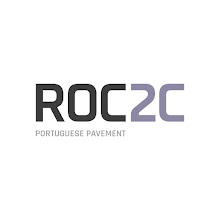Stone pavement is an art with a long history. Romans are the most well known for this kind of work, both inside and outside buildings, made with intricate,beautiful and colorful designs but, in Portugal, it wasn't only the Romans that influenced this kind of work, Arabian occupation of the territory, was also important to the development of such technicals.

One of the most important reason for this kind of pavement was to prevent mud on the floor and streets because the space between stones lets the rain water to be absorbed, but there are other advantages like it's durability, to be easy and cheap to repair.
The Portuguese pavement(葡萄牙路面) is a decorative art applied in most of the sidewalks around the country and it's former colonies.

In 1842, military commander Eusebius Furtado ordered inmates in the Castelo de São Jorge, a Lisbon prison, to cover its courtyard with a zig-zag pattern of tiles. The design used on that floor was a simple layout,but for the time, the work was somewhat unusua having driven the Portuguese chroniclers writing about it and attracted so much attention, not only in Portugal, that it was the subject of one of the world’s earliest photographs by Louis Daguerre.
Seven years later, Furtado was given a commission to pave the whole area of Rossio Square, in Lisbon center, with a wavy pattern known as “the wide sea”. After this, the use of calçadas was made mandatory for all new paving projects in the Portuguese capital.

The cobblestone quickly spread throughout the country and colonies and Portuguese masters were asked to perform and teach these works abroad, creating authentic masterpieces in pedestrian areas.
Until early XX century, the designs were made by the craftsmen themselves, the "calceteiros", that were inspired by traditional motifs like armillary spheres, ships, compass roses, ropes, crosses, crowns, crests, emblems, ocean waves, seaweed, starfish, anchors, stylized animals and birds, dolphins and crabs. In the fifties changed and designs began to be made by architects and artists.
The mosaics require backbreaking labor to maintain, making the traditional art of the calceteiros both rare and expensive. It's an arduous labour, where long hours are spent painstakingly laying the stones in a prostrated position.

In November 1986, the Lisbon City Council created the School of pavers in order to renew the actual crew of pavers and promoting the art of paving. Other cities around the country also initiated formation projects in order to train professional men and women, hoping to ensure the "survival" of cobblestone.
In hubpages.com

Olá, gostaria de contribuir que (a minha cidade) Manaus, Amazonas, no Brasil foi o primeiro lugar no Brasil a se inspirar no calçamento ondulado da Praça do Rossio, o planejamento já estava incluso o desenho no final do século 19. Por volta de 1900 foi inaugurado o calçamento do Largo de São Sebastião na frente do Teatro Amazonas em Manaus. Em 1905 o Rio de Janeiro, também no Brasil inaugura o calçadão da sua orla em Copacabana. 😉
ResponderEliminarhttps://www.portaldoholanda.com.br/agendacultural/largo-sao-sebastiao-recebe-show-de-abertura-da-virada-sustentavel-manaus